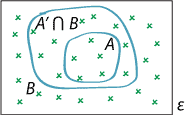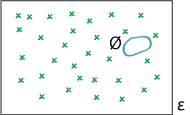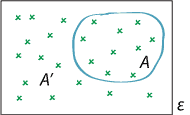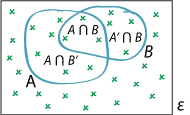Content
Useful properties of probability
We now look at some of the consequences of the three axioms of probability given in the previous section.

Event \(A\) is a subset of event \(B\).
Detailed description
Property 1
If the event \(A\) is a subset of the event \(B\), then \(\Pr(A) \leq \Pr(B)\). That is,
\[ A \subseteq B \ \implies \ \Pr(A) \leq \Pr(B). \]Proof
- Consider events \(A\) and \(B\) such that \(A \subseteq B\), as shown in the diagram above. Then \(B = A \cup (A' \cap B)\), and the events \(A\) and \(A' \cap B\) are mutually exclusive. Thus, by the third axiom, \(\Pr(B) = \Pr(A) + \Pr(A' \cap B)\). The first axiom tells us that \(\Pr(A' \cap B) \geq 0\). Hence, \(\Pr(A) \leq \Pr(B)\).
\(\Box\)
This property has a useful application. We write \(A \Rightarrow B\) to mean that, if \(A\) occurs, then \(B\) occurs. So \(A \Rightarrow B\) is the same as \(A \subseteq B\), which implies \(\Pr(A) \leq \Pr(B)\). For example:
- Indiana Jones can only find the treasure (\(A\))
- if he first solves the puzzle of the seven serpents (\(B\));
While property 1 is important, it is rather obvious.
Property 2
\(0 \leq \Pr(A) \leq 1\), for each event \(A\).Proof
- The first axiom says that \(\Pr(A) \geq 0\). It is true for every event \(A\) that \(A \subseteq \mathcal{E}\). Hence \(\Pr(A) \leq \Pr(\mathcal{E})\), by property 1. But \(\Pr(\mathcal{E}) = 1\), by the second axiom, and so it follows that \(\Pr(A) \leq 1\).
\(\Box\)
This property formalises the scale for probabilities, given the axioms.

The empty event.
Detailed description
Property 3
\(\Pr(\varnothing) = 0\).Proof
- Choose any event \(A\). Then the two events \(A\) and the empty set \(\varnothing\) are mutually exclusive, so \(\Pr(A \cup \varnothing) = \Pr(A) + \Pr(\varnothing)\), by the third axiom. Since \(A \cup \varnothing = A\), this gives \(\Pr(A) = \Pr(A) + \Pr(\varnothing)\). Hence, \(\Pr(\varnothing) = 0\).
\(\Box\)
It would be rather strange if the probability of the empty set was anything other than zero, so it is reassuring to confirm that this is not so: \(\Pr(\varnothing) = 0\), as expected.

An event \(A\) and its complementary event \(A'\).
Detailed description
Property 4
\(\Pr(A') = 1 - \Pr(A)\), for each event \(A\).Proof
- The events \(A\) and \(A'\) are mutually exclusive, so \(\Pr(A \cup A') = \Pr(A) + \Pr(A')\), by the third axiom. But \(A \cup A' = \mathcal{E}\), and therefore \(\Pr(A') = \Pr(\mathcal{E}) - \Pr(A)\). According to the second axiom, \(\Pr(\mathcal{E}) = 1\). Hence, \(\Pr(A') = 1 - \Pr(A)\).
\(\Box\)
This property is surprisingly useful and is applied frequently. It is most effective when the probability of the event of interest is difficult to calculate directly, but the probability of the complementary event is known or easily calculated.
Exercise 3
Suppose that, in a four-child family, the probability of all four children being boys is 0.07. What is the probability that a four-child family contains at least one girl?
Property 5 (Addition theorem)
\(\Pr(A \cup B) = \Pr(A) + \Pr(B) - \Pr(A \cap B)\), for all events \(A\) and \(B\).
 Detailed description |
|
||||||||||
| Two representations of the addition theorem. | |||||||||||
Both the diagram and the table above give representations of the event space \(\mathcal{E}\) in terms of the two events \(A\) and \(B\) and their complements.
The impression we get from the diagram, from the table, or just using basic logic is that, if we add together the probability of \(A\) and the probability of \(B\), then \(A \cap B\) is included in both events, so it has been counted twice. Hence, to obtain the probability of at least one of \(A\) and \(B\) occurring, that is, to obtain \(\Pr(A \cup B)\), we need to subtract \(\Pr(A \cap B)\) from \(\Pr(A) + \Pr(B)\). This justifies the formula given by the addition theorem (property 5). We can demonstrate the result more formally, as follows.
Proof
- To devise a formal proof of the addition theorem, we construct mutually exclusive events in a helpful way, and use the third axiom of probability.
We can express the union of \(A\) and \(B\) as \(A \cup B = A \cup (A' \cap B)\), and the events \(A\) and \(A' \cap B\) are mutually exclusive. Also, \(B = (A \cap B) \cup (A' \cap B)\), and the two events \(A \cap B\) and \(A' \cap B\) are mutually exclusive. By applying the third axiom to the first of these relationships, we get that \[ \Pr(A \cup B) = \Pr(A) + \Pr(A' \cap B). \] And using the third axiom for the second relationship, we find that \begin{align*} \Pr(B) &= \Pr(A \cap B) + \Pr(A' \cap B)\\ \implies \ \Pr(A' \cap B) &= \Pr(B) - \Pr(A \cap B). \end{align*} Hence, \(\Pr(A \cup B) = \Pr(A) + \Pr(B) - \Pr(A \cap B)\), as required.
\(\Box\)
Exercise 4
Lego sells `minifigures'. There are 16 distinct minifigures, and they are distributed at random among shops (it is said). Furthermore, the minifigures cannot be identified prior to purchase and removal of the packaging. A young child wishes to obtain the `Pirate Captain', one of the 16 figures in Series 8. She persuades her parent to buy a minifigure at two different shops. Define the events:
- \(A\) = "Pirate Captain is purchased at the first shop"
- \(B\) = "Pirate Captain is purchased at the second shop".
Assume that the distribution of the minifigures is random across shops, and assume that \(\Pr(A \cap B) = \dfrac{1}{256}\).
- What is \(\Pr(A)\)? \(\Pr(B)\)?
- What is the probability of the child's wishes being satisfied?
- Describe each of the following events in words:
- \(B'\)
- \(A' \cup B'\)
- \(A \cap B'\)
- \(A' \cap B'\).
- Which event is more probable: \(A \cup B\) or \(A' \cap B'\)?
